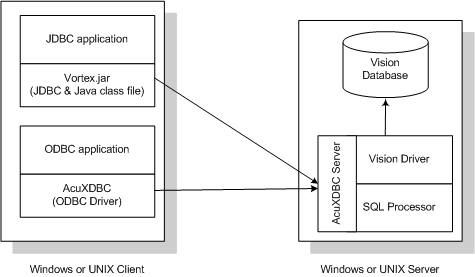Remote Processing (Network or Client-Server)
In a two-tier configuration, the client computer is running the ODBC/JDBC application or the command-line query tool. The data to be processed resides on a remote UNIX or Windows server. With AcuXDBC Server (xdbcsrvr) running on the remote machine, your application is able to take advantage of server-side processing of the SQL statements.
Remote processing can mean more efficient use of your system resources. Queries often process large amounts of data to get results. Remote processing decreases the amount of data that must be transferred between the client and the server. If files reside on the same server on which processing occurs, network traffic is reduced. Only the final result of the processing is returned to the client machine. In addition, this structure encourages centralized management of your data, cutting down on duplication and ensuring that the information returned to the application is up-to-date.
For remote processing on a Windows server, xdbcsrvr resides as a service on the remote machine, waiting for calls for SQL processing. On UNIX machines, xdbcsrvr resides as a daemon. xdbcsrvr is a single-instance server: each time it gets a request, it spawns a new copy to deal with the request, and the original goes back to listening for additional requests. You may run xdbcsrvr continuously, or start and stop it.
The following illustration depicts the architecture for remote SQL processing.
